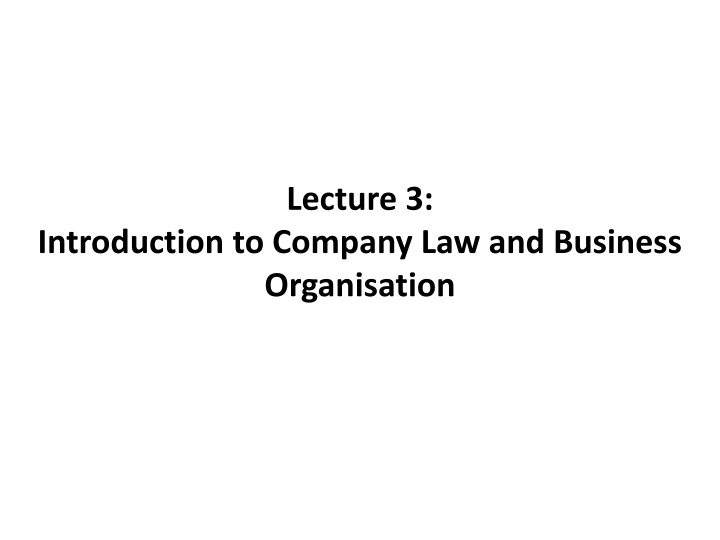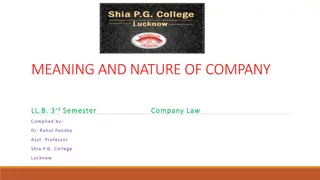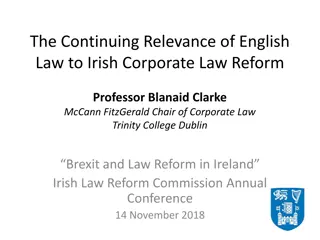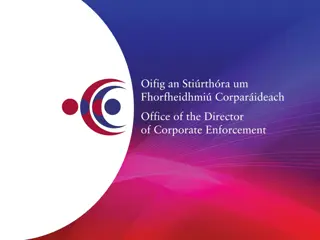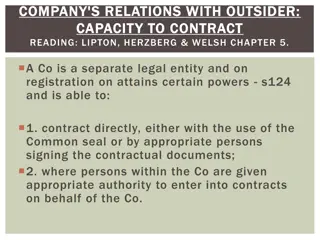Introduction to Company Law and Business Organisation
This content covers various forms of business organisation such as Sole Proprietorship, General Partnership, Limited Partnership, Limited Liability Partnership, and Limited Liability Company. It delves into the legal consequences of business structure choices including legal personality, incorporation, and limited liability. Additionally, advantages and disadvantages of Sole Proprietorship and General Partnership are discussed, along with key aspects of partnership laws.
Download Presentation

Please find below an Image/Link to download the presentation.
The content on the website is provided AS IS for your information and personal use only. It may not be sold, licensed, or shared on other websites without obtaining consent from the author.If you encounter any issues during the download, it is possible that the publisher has removed the file from their server.
You are allowed to download the files provided on this website for personal or commercial use, subject to the condition that they are used lawfully. All files are the property of their respective owners.
The content on the website is provided AS IS for your information and personal use only. It may not be sold, licensed, or shared on other websites without obtaining consent from the author.
E N D
Presentation Transcript
Lecture 3: Introduction to Company Law and Business Organisation
Common forms of business organisation Sole General Partnership Proprietorship Limited Partnership Limited Liability Partnership Limited Liability Company
Business legal consequences Three concepts which are recurring themes in the law relating to business organisation: Legal personality- legal rights and duties Incorporation-brought into being by operation of law, legal personality, one or more members Limited liability-liability is the corporation s and not its members
Sole Proprietorship or Sole Trader Owner is actually the business. Business is not a separate legal entity and has total responsibility for the legal responsibilities. Has independent control of the business and all the profits & financial risks
Advantages of a Sole Proprietorship Ease and low cost of formation. Owner can make all management decisions. hiring and firing employees. No other approvals required. Sole proprietor owns all of the business Has the right to receive all of the business s profits. Easily transferred or sold
Disadvantages of a Sole Proprietorship Access to capital is limited to: personal funds plus any loans he or she can obtain. Legally responsible for the business s contracts Responsible for any torts committed in the course of employment. Limited access to capital Potential for long hours
General Partnership Two or more people carrying on business together and not registering a company to use for their business. Three Types of Partnership possible: Partnership Act 1890 Limited Partnership Act 1907 Limited Liability Partnerships Act 2000 Partnership Act 1890 - the oldest and most basic model for setting up a company. Strongly based on contract and equity in respect of relations among the owners ( partners ). Partnership Agreement can be written or unwritten Section 1(1) PA 1890: Partnership is the relation which exists between persons carrying on business in common with a view to profit.
Partnership Agreement It is called a partnership agreement or articles of partnership .
Partnership Relationship Business partners are in a fiduciary relationship with each other. They are placed in a position of trust with each other: To make full disclosure to each other of all relevant issues to the business To declare any personal financial benefit received by a partner in carrying out the firm s business Not to compete with the firm without the consent of the other partners
Duties Among Partners Duty of Loyalty Duty of Obedience Duty to Inform Duty of Care
Duty of Loyalty Duty that a partner owes not to act adversely to the interests of the partnership. Duty is imposed by law Cannot be waived. In case of conflict between partnership interests and personal interests, partner must choose the interest of the partnership.
Duty of Care Partners must use the same level of care and skill that a reasonable person in the same position would use in the same circumstances. A breach of the duty of care is negligence. A partner is liable to the partnership for any damages caused by his or her negligence.
Duty to Inform Duty partner owes to inform his or her co-partners of all information he or she possesses, that is relevant to the affairs of the partnership. Knowledge is imputed to other partners.
Duty of Obedience Duty that partners must adhere to the provisions of the partnership agreement and the decisions of the partnership. Partner who breaches this duty is liable to the partnership for any damages caused by the breach.
Partners Breach their duty of loyalty if they: 5. Disclose confidential partnership information 6. Misuse partnership property 7. Make other breaches of their fiduciary duty 1. Self-deal with the partner- ship without permission 2. Usurp a partnership opportunity 3. Compete with the partner- ship without permission 4. Make secret profits from partnership business
Dissolving The Partnership Partnership may come to an end for the following reasons: Lapse of time: the period of time stipulated in the Partnership agreement or the duration agreed. The sole purpose of the partnership is achieved Death or bankruptcy of a partner: If no provision is made for this, it may result in dissolution Illegality: if the purposes of the partnership subsequently becomes illegal Notice from a Partner: If one of the Partners decides to leave (the partnership agreement should provide for this) Court Order: a partner may ask the Court to order the dissolution of the Partnership on the grounds of mental or physical incapacity of a partner; or misconduct by a Partner prejudicial to the business
Registered Companies A Corporation created in compliance with the registration procedures in the Companies Act 2006 and monitored by the Companies Registry
Converting a Private into a Public Limited Company The main reason for choosing to convert a private company to a PLC is the ability of the latter to offer their shares for sale to the general public. In effect, this means that public limited companies can list their shares on a stock exchange.
Main difference between private and public companies Most companies in the UK are private limited companies (LTDs). They are legally distinct entities with their own assets, profits and liabilities. The personal finances of any shareholders are protected by limited liability (i.e. their liabilities are limited to the value of their shares). Shares in private companies cannot be offered to the general public. Public limited companies (PLCs) are similar to private limited companies, in the sense that they are legally distinct entities with their own assets, profits and liabilities. However, shares in a public company can be freely sold and traded to the general public and their shares can be listed on a stock exchange. PLCs are the only type of company allowed to raise capital from this type of public investment.
Forming a Company The articles of association are the one constitutional document for new companies created under the 2006 Companies Act ss 9-13. For registration the following documents are filed with the Registrar of Companies in England and Wales, or Scotland or Northern Ireland (as the case may be): The memorandum of association An application for registration sections 9 to 12 A
The app for registration must contain the following company name jurisdiction where reg d office situated whether liability of members limited and, if so, whether by guarantee of shares whether Co, PLC or private limited company and name and address of any agent filing it section 9(2) & (3)
Effects of Registration Under section 15 of Companies Act 2006 a certificate of incorporation is issued with much the same information as before and, is conclusive evidence that the requirements of the Act as to registration have been complied with and that the company is duly registered clause 15(4). This appears to continue position as existed at common law - Bowman v Secular Society [1917] AC 406 (HL).
Purposes of Registration To check before it starts that a business is financially viable, has a reasonable chance of success and is likely to be reputably managed for legal purposes before it starts trading To provide a public record of all such businesses, which may be inspected by interested parties before trading with or investing in them To guard against fraud To enable continuing supervision of the company by the Companies Registrar.
Registrar may refuse registration and trading certificates Where the object of the company is entering into contracts that are sexually immoral the AG may seek a judicial review objecting to the registration. Only the Crown can challenge lawfulness of incorporation as happened in : R v Registrar of Companies, ex p Her Majesty's Attorney General [1991] BCLC 476 A trading certificate is conclusive evidence that the company is entitled to do business and exercise any borrowing powers s761(4) of Companies Act. A company which trades when it does not have a trading certificate could face criminal sanctions s767 (1) and (2).
Companies and Liability Very few unlimited companies given that the shareholders or (or members) of this type of company have unlimited liability.
Companies Limited by Guarantee The Companies Act 2006 provides for two kinds of guarantee one, companies limited by guarantee and not having a share capital second, companies limited by guarantee and having a share capital. This second type of company has been in effect abolished by the Companies Act 1980.
So what does a company limited by guarantee and not having a share capital mean in practice? Companies limited by guarantee without a share capital are typically used for non-profit organisations and clubs that require legal personality that is they must be capable of existing in law.
Company is limited by guarantee rather than capital So an example: a statement of guarantee may amount to any sum the subscribers to the document agree to so it could be 10 or 1000. The guaranteed amount is not part of the capital assets of the company and cannot be mortgaged against. If the club goes into liquidation the maximum extent any one of the guarantors can be liable is the amount of the guarantee they put in.
Companies if Charities are exempt from using the word limited as part of their name. To claim this exemption a statement must be delivered to the registrar at Companies House stating that the company meets the conditions for the exemption which the registrar may accept the statement as evidence of grounds for the exemption.
The Public Company A company whose shares may be transferred freely to members of the public; May be listed on the Stock Exchange: must satisfy the requirements of the Financial Services Act 1986; In practice only large companies will be eligible Most members of a public company will aim to share in its profits without taking any part in its management
Criteria for Registration (Public Company) The memorandum of association of the company must state expressly that the company is to be a public company The name of the company must indicate its public status (suffix plc ) must follow the company s name The company s authorised capital must not be less than the statutory minimum: currently 50,000. At least 25 percent of this must already be paid up in shares ( 12,500) It must have limited liability
Consequences of Incorporation The company is a separate entity distinct from its members Company Members may enjoy limited liability for the company s debt Shares: liability is limited to the value of their shares Guarantee: the amount shareholders have agreed to pay if the company is wound up The company may be legally liable Criminal offences: may be prosecuted for crimes Tort: damage/negligence by employees and agents committed in the course of their employment Breaches of contract
Consequences of Incorporation (contd.) Ownership and management owned by its members and managed by its directors Public Accountability Once registered certain information about it is opened to public scrutiny and must be updated yearly through the annual return; Unlimited companies are exempt Continuous Succession: continues to exist until the legal process of liquidation brings the process to an end Compulsory liquidation: by court order under the Insolvency Act 1986; if unable to pay its creditors Voluntary liquidation: whether the company is still solvent, then the members control the liquidation process
Corporate Manslaughter and Corporate Homicide Act 2008 Under the Corporate Manslaughter and Corporate Homicide Act 2008 an organisation is guilty of corporate manslaughter if the way in which its activities are managed or organised causes a death and amounts to a gross breach of a duty of care to the person who died. A substantial part of the breach must have been in the way activities were organised by senior management. Please take some time and look at this: R. v Cotswold Geotechnical Holdings Limited (2011) EWCA Crim 1337WCA Crim 1337
The Differences Between a Partnership and a Registered Company Partnership Creation A written partnership agreement is usual but not essential. The parties conduct (jointly doing business with a view to profit) will create a partnership Numbers Minimum: at least two. Maximum: 20 Legal Personality The partnership has no separate legal personality of its own: partners vicariously liable for any breaches of civil law caused by a fellow partner in the course of the business. Any partner may be personally liable for crimes relating to the business Company Creation The company does not exist until the registration procedures of the Companies Acts have been complied with Numbers A one-person private company is possible. No maximum is prescribed Legal Personality Once registered a company has its own legal personality separate from that of its members. Members cannot be made liable for illegal activities
The Differences Between a Partnership and a Registered Company (contd.) The Partnership Limited liability The Partners have unlimited liability for the debts of the business, unless registered as a limited liability partnership The Company Limited liability A company s liability is unlimited. Members may have limited liability for company debts
The Differences Between a Partnership and a Registered Company (contd.) Supervision and Publicity The running of a partnership is not supervised by any outside authority. Partnership accounts and other documentations are confidential to the partners unless the partnership is a LLP. Supervision and Publicity A limited liability company is monitored by the Company s Registrar through its annual return. Particulars and accounts are open to public inspection. The DTI has wide investigative powers Termination Once created a company has continual succession. It will not cease to exist unless or until the legal processes involved in winding up are complete Termination Completion of object, lapse of time, partner leaves, bankruptcy, mental disability or death of a partner
Impact of Human Rights Act 1998 on Business Organisations Property rights: a business may be able to protect its property by reference to Protocol1 Article 1, Peaceful enjoyment of property Privacy: employees rights to privacy and family life Fair trial: A business and its employees enjoy the right to a fair trial Freedom of speech: An organisation has the right to freedom of speech (Venables v News Group Newspapers 2001)
